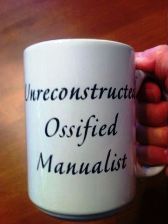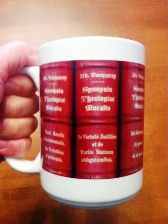
The Scruple Spoon
From a reader…
QUAERUNTUR (I generally take ONE question at a time, but I am feeling benign this afternoon… a rare occurance):
Your recent post this afternoon about validity around a Priest using “for all” instead of “for many” made me think of my own questions regarding validity based upon recent experience.
1) is it valid if the priest pours too much water into the chalice causing the wine to become diluted?
2) An older priest that says daily Mass regularly at a parish I attend does not break off a fraction of the host and place in the chalice before the “Lamb of God”. Does this render the Mass invalid?
Ad 1m. If the priest adds too much water to the wine in the chalice, he “breaks” the substance of the wine. At that point, there is no wine to consecrate and, hence, there can be no consecration. That means that Mass was not celebrated. However, it is possible that the Host was consecrated. That means that the priest, technically, consecrated the Eucharist outside of Mass, which is a serious sin and crime. Mind you, it can happen that an older fellow or a priest who isn’t tracking very well might do this by accident. If that happens more than once, someone should be with him to correct the situation. More wine must be added, for example. Another way to avoid this is the use of the so-called “scruple spoon”. I have a photo of one of these great gizmos among the headers for this blog. With the “scruple spoon”, Father is able to dip up a tiny bit of water and add it to the chalice. Easy.
 The next part of this question is, obviously, how much water is too much?
The next part of this question is, obviously, how much water is too much?
For this we, being good Unreconstructed Ossified Manualists, refer to our old manuals. In the manual of dogmatic theology by Tanquerey, that tonic for the soul, I found the opinion that “quinta pars aquae ad vinum corrumpendum non sufficiat … a fifth part of water isn’t enough to break [the substance of] the wine”, and thus render it invalid matter for consecration.
Think about it. One fifth of the volume of the wine usually isn’t very much. So, priests should be very careful about this. FATHERS! DEACONS! SEMINARIANS! PAY ATTENTION!
Ad 2m. No. Not putting the particle of Host into the Precious Blood does NOT invalidate the Mass. At this point the priest has the Body and Blood of the Lord on the altar. Now the critical thing is that he must consume them both to complete the Sacrifice. Putting the particle into the chalice is highly significant, but it is not an element which is absolutely essential for Mass to have been celebrated. This element could have developed from the ancient practice of the Bishop of Rome breaking pieces from his Host and sending them out to all the tituli (“parishes”) of the City to show their unity. At last, some saw the mingling of the Body with the Blood as a sign of the Resurrection. If the two-fold consecration is the separation of the Blood from the Body, and therefore the death of the Lord, then their rejoining is like His resurrection. Thus, when we receive Communion we have been given then sign that what we receive is truly the Lord gloriously risen. This commingling should also give us a great sense of peace. In the older form of Mass the priest makes the sign of the Cross thrice with the particle from rim to rim of the chalice saying, “May the peace of the Lord be with you always”.



































I learned in the seminary that if what was in the chalice still smelled like wine and tasted like wine it was consecrated. If it tasted like watered-down wine it was doubtful and if had lost its taste or smell it was not consecrated. [Too late.]
In high school, my religion teacher told us that if a priest is an alcoholic, he is allowed to mix one drop of wine with a full glass of water, and the Mass is still valid.
Based on your reply above, what I learned in high school is obviously false. But I wonder: Is this a commonly believed falsehood, or was this invented by my high school teacher on his own?
It is the custom in the Syriac Churches to mix equal parts wine and water in the chalice to demonstrate the full humanity and divinity of Christ. In fact, the epiclesis over the chalice in some recensions says “and make the MIXTURE in this chalice the Blood of Christ our God.”
Though it must be noted that great care is taken to maintain equal proportions so a separate cup is typically used to portion out equal amounts so there is never more water than wine.
If there are 20 “communion cups” of wine and one presider’s chalice of wine, and he adds “too much” water considering the volume only of the main chalice yet still a modest amount in proportion to the 21 filled vessels, are all the vessels of wine validly consecrated, or is only the presider’s chalice not validly consecrated while the numerous communion cups become the Precious Blood? Or other?
OK, now I’ll throw a curve. At the N.O. Mass, their are three chalices on the altar. If the priest pours
more than 1/5 water in his chalice and none in the others, has the water “broken” all the wine? Would there be valid matter in the two remaining chalices, or none because no water was mixed in those? My head hurts in thinking about is, but the answer is important.
Of course, the other significant thing about the pax is that it’s the first thing Our Lord said to the Apostles when he met them after the resurrection. Lovely piece of symbolism!
On what Wesley D said,
one drop of wine in a glass of water is not wine.
If the priest is an alcoholic, he can ask for permission to use Grape Juice, provided that the fermentation has only been stopped by freezing, because then after defreezing it’s technically must and of the same nature as wine. [Not grape juice… mustum.]
However, if he is an alcoholic – and I mean of the sort properly called “alcoholic”, i. e., really suffering a relapse after the tiniest amount consumed (not just a physically healthy man who has a thing which is just one of all these vices in the world, that of drinking too much) – he should not be ordained in the first place (based not on a morality argument, but on precisely this incapability).
And while depending on the strictness of the observer (and perhaps his willingness to tax the Church with supposedly immoral personnel), some priests may be diagnosed to have “drinking problems”… I do wonder whether any priest not totally abandoning his pastoral office gets even the time to really develop alcoholism properly so-called, if he had not had it at Ordination.
Use of a Scruple Spoon for the water would cause the wine to not be overly diluted. (A scruple is the Apothecaries’ unit of weight equaling 1.296 grams.)
Regarding the Fraction – I have forgotten from whom I had heard or read what I am going to relate; it may have been Dr. Brant Pitre or Dr. John Bergsma, or someone else associated with the St. Paul Center for Biblical Theology. In any case, I think the ultimate source might be Edersheim. It pertains to what a sacrifice is. When an sacrificial offering is made, that which is sacrificed is set apart fro God alone. It the case of an animal in the Old Temple, it was take by the priest and blessed with the imposition of hands. It was then taken and slaughtered. It’s parts were separated into those to be burned and so sent to Heaven as smoke, as it were, and those to be eaten by the priest. Then, the whole offering was reassembled to show that nothing made sacred to God had been taken away. Then the entrails and skin and fat burned, and the meat cooked and eaten. Our churches and the Temples of the Israelites are both types to which the Heavenly Temple not made by the hands of men is the antitype, and so our sacrifices. The host is taken and consecrated, divided (broken for you), reassembled, and consumed. This, I think, was posited as the reason for the fraction of the Host.
I have also personally often wondered if the real nature of the priesthood of all the baptized is that we are all able to consume the Sacrifice as were the priests of old, not all of whom were able to offer sacrifice, though priests they were. From a monumental perspective, the people coming making the offering to the sacrifice would come to and kneel at a low railing. And then the sacrifice would be taken up the three levels of the temple to the altar.
Through both Luther’s neo-Marcionist heresy and the modernists’ immanentist heresy, the Enemy would deracinate us from the kahol/ecclesia/assembly of God’s faithful in the Old Testament. But God showed what is in the Old Testament to help us understand the New, and we neglect his plan and our past at our own great peril.
Pingback: SVNDAY CATHOLICA EDITION | Big Pulpit